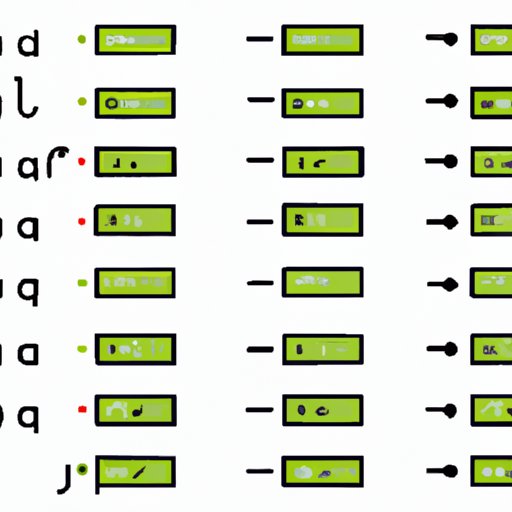Introduction
An array is one of the most important building blocks of computer science. It is a type of data structure that is used to store and manipulate data. Understanding the basics of how arrays work is essential for any programmer who wants to be able to write efficient code and create complex data structures. In this article, we will explore what an array is in computer science, how to use them when writing code, the many benefits of utilizing arrays in programming, and an overview of their uses in computing.

Exploring the Basics of Arrays in Computer Science
In order to understand what an array is in computer science, it’s important to first define the term. An array is a collection of elements stored in a specific order. The individual elements can be of any data type, including integers, floats, characters, strings, and objects. There are two main types of arrays: static and dynamic. Static arrays have a fixed size, meaning that once they are created, they cannot be changed. Dynamic arrays, on the other hand, can grow or shrink depending on the needs of the program.
Arrays are used to store and manipulate data in computer programs. They are often used to store collections of data such as numbers, strings, or objects. Arrays are also used to perform calculations on large sets of data, such as sorting or searching. By storing data in an array, programmers can quickly and easily access the information they need.

How to Utilize Arrays when Writing Code
Different programming languages handle arrays differently. In some languages, such as Java, arrays are treated as objects and must be created with the “new” keyword. In other languages, such as C++, arrays are treated as primitive data types and must be declared with a specific size. Regardless of the language, however, all programming languages provide methods for creating, manipulating, and deleting arrays.
To get started using arrays in your code, you’ll need to learn the syntax for declaring, initializing, and manipulating them. Here is a simple example of how to declare and initialize an array in Java:
int[] myArray = new int[10]; // Declare and initialize an array of 10 integers
Once an array has been declared, you can use various methods to manipulate it. For example, you can add and remove elements from the array, sort the elements, search for specific elements, and more. Here is a simple example of how to add an element to an array in Java:
myArray[2] = 5; // Add the value 5 to index 2 of the array
Finally, once you’ve finished working with an array, you can delete it from memory by setting it to null. Here is an example of how to do this in Java:
myArray = null; // Delete the array from memory
The Many Benefits of Arrays in Programming
Using arrays in programming can offer many benefits. One of the primary advantages of using arrays is increased speed and efficiency. Arrays allow for quick and easy access to data, which makes them ideal for processing large amounts of data in a short amount of time. Additionally, arrays make it easier to access and manipulate data, as they are organized into a single block of memory.
Another benefit of using arrays is improved organization of data. Arrays allow for the efficient storage of data in a structured format. This makes it easier to locate and retrieve data from an array, as well as organize it into meaningful chunks. Additionally, arrays can help to reduce memory usage by eliminating unnecessary redundancy.

An Overview of Arrays and Their Uses in Computing
Arrays are used in a variety of areas in computer science. They are commonly used in graphics and game programming, where they are used to store and manipulate large amounts of data. Additionally, arrays are used in web development, where they are used to store and retrieve user data. Arrays are also used in databases to store and query data.
To better understand how arrays work, there are several visualization tools available. These tools allow users to view the contents of an array and see how it changes as data is added, removed, and manipulated. Additionally, there are a number of popular algorithms that use arrays, such as quicksort and mergesort.
A Comprehensive Guide to Understanding Arrays in Computer Science
For those who are interested in learning more about arrays in computer science, there are a number of advanced topics within array theory. These topics include multidimensional arrays, sparse arrays, and circular arrays. Additionally, there are a number of complex data structures that utilize arrays, such as heaps and hash tables.
For further study, there are a number of books and online resources available. A few suggested readings include “Data Structures and Algorithms in Java” by Robert Lafore, “Algorithms” by Sanjoy Dasgupta, and “Programming Pearls” by Jon Bentley.
Conclusion
In conclusion, arrays are an essential part of computer science. They are used to store and manipulate data in a structured format, allowing for increased speed and efficiency. Additionally, they offer numerous benefits, including easier access to data, improved organization of data, and reduced memory usage. Finally, arrays are used in a variety of areas in computer science, including graphics and game programming, web development, databases, and more.
Understanding arrays is essential for any programmer who wants to be able to write efficient code and create complex data structures. By exploring the basics of arrays in computer science, how to utilize them when writing code, the many benefits they offer, and their uses in computing, anyone can gain a comprehensive understanding of what an array is and how to use them effectively.
(Note: Is this article not meeting your expectations? Do you have knowledge or insights to share? Unlock new opportunities and expand your reach by joining our authors team. Click Registration to join us and share your expertise with our readers.)
